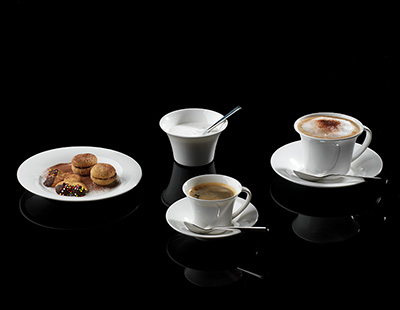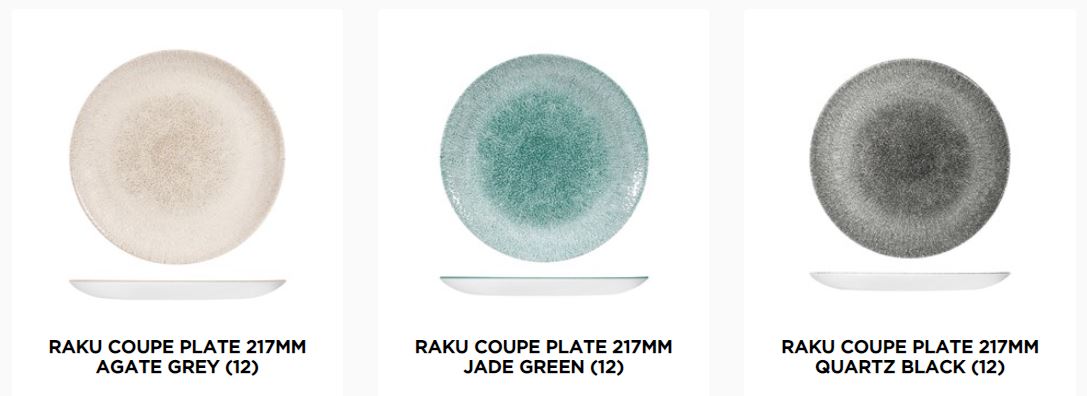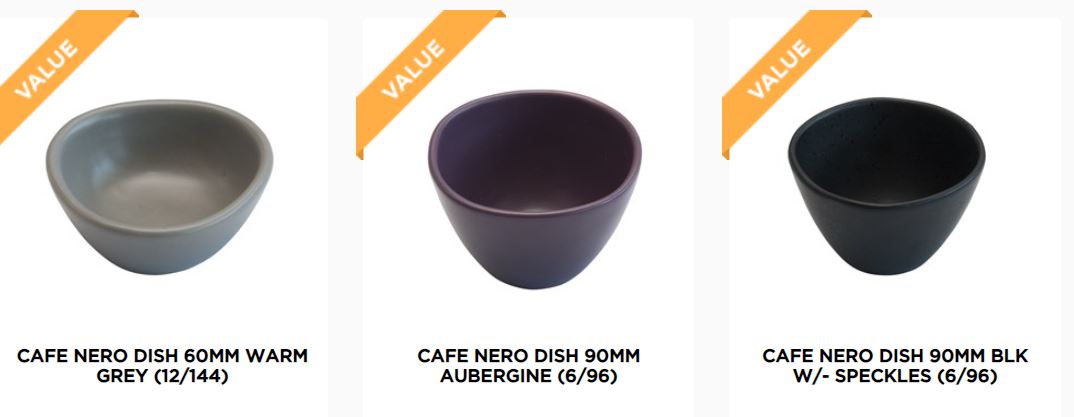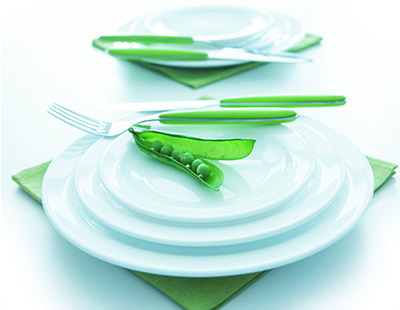The perfect plates and bowls will shine a spotlight on your menu. Consider them the stage, the meals you serve the singers, and the menu the opera you are staging to tantalise tastebuds. It’s a production. Each element is underwhelming on its own, but when pieced together perfectly – the orchestration of food service encompasses the audience with sensory overload.
Your selection of crockery should not be overlooked. It sets the tone for your customers and highlights the food you have on offer. Making the right selection can be overwhelming so we’ve put together this guide to ensure you make the right decision when choosing from our extensive range of dinnerware.
What Is Crockery Or Dinnerware?
Crockery is the bed (or capsule) you serve food on or liquid in. It encompasses plates, dishes, saucers, bowls, serving platters, vessels, cups, and teapots you serve your menu on or in. Crockery is also referred to as dinnerware or china.
When selecting dinnerware to meet your dining needs, the most obvious and popular is a strong and durable crockery set that retains heat and is dishwasher-friendly. However, there are an array of options available depending on your desire to put a spotlight on your menu while setting the tone for your diners.
How Is Crockery Made?
Dinnerware is made of ceramic materials such as earthenware, stoneware, bone china and porcelain. The triumph of ceramic crockery is due to the popularity of ceramic glazes which developed in Europe. Before the mass production of tableware, it was carved from wood. Industrialisation, and advancements in the use of ceramic, introduced large quantities of inexpensive and washable tableware.
Tableware can be produced via many methods. These can include hand moulding with setting via firing in an earn, complex machinery that moulds the item before sending it through a high-heating urn-like contraption; Or a factory churning agents through moulds and setting contraptions akin to mass production facilities.
The various ways crockery is made, the materials used and the production processes, result in the attributes of the final product. No two are the same and the result of dinnerware products is the difference between the items used in fine dining restaurants, versus aged care facilities, versus high-turnover cafes.
The choice is yours to make based on the impression you want to instil in your customers. Various types of crockery have their advantages, disadvantages, and aesthetic versus functional appeal.
What Are The Different Types Of Crockery?
We will outline the various types of dinnerware below. The eight categories covered are:
Fine Bone or New Bone China
Porcelain (also called China)
Vitrified Ceramic
Stoneware
Earthenware
Vitrified Glass
Enamelware
Melamine
Fine Bone China or New Bone China
Fine Bone China is a type of porcelain primarily composed of two materials: animal bone ash and porcelain clay. It is set in a kiln at a lower temperature than porcelain allowing it to form into a lightweight, translucent, and smooth-to-the-touch piece of crockery.
Fine Bone China is the strongest ceramic in the world with a very high mechanical and physical strength. This means it is highly chip-resistant and white dinnerware made from this process is the whitest available.
Fine bone china is dishwasher, microwave, and oven safe unless the manufacturer indicates otherwise. If the dinnerware is decorated with a metallic rim, they are not suitable for microwaves. Always check the manufacturer’s advice before proceeding.


New Bone China has the same attributes as Fine Bone China, without the use of animal bone ash. It instead uses an innovative mixture of Alumina Oxide which has the same mechanical and physical strength as the animal bone ash.
This more animal-friendly approach to dinnerware production, in place of Fine Bone China, is widely celebrated and the most popular choice of the two.
New bone china is advised to be hand-washed or placed in a dishwasher on a gentle cycle with mild detergent. Use in microwaves or ovens is not recommended unless the manufacturer advises it is safe to do so.
Porcelain (Standard China)
Porcelain, the standard china we commonly know, refers to crockery that is made from fine particle clay. The fine particle clay is typically comprised of Feldspar, Kaolin, and Quartz. It is fired at a higher temperature than other types of crockery creating a non-porous product that is extremely durable. This means the piece can be thinner and more delicate than others, sometimes with a translucent appearance. It allows for shaped details to be incorporated, giving the designer room for maximum creativity in its appearance.
Most porcelain, or standard china, is dishwasher, microwave, and oven safe unless the manufacturer indicates otherwise.


Vitrified Ceramic
Dinnerware that is vitrified is highly non-porous. Porous crockery is susceptible to breakages and with the vitrification firing process, the crockery is superior in strength due to the elimination of moisture and air pockets.
Vitrification occurs at very high temperatures resulting in the creation of a heavier and thicker material recognised for its ability to retain heat. In the firing process, Alumina Oxide is added for extra strength making vitrified ceramics tough and ideal for perfect use.
Vitrified ceramic plates can withstand repeated use in the dishwasher or oven. Microwave use is based on manufacturer advice.


Stoneware
Stoneware is thicker and more opaque than finer materials like porcelain and china. During the firing process, vitreous glass materials are added resulting in the stoneware being extremely strong. The kiln temperature is lower than porcelain and vitrified ceramics allowing for the introduction of a variety of glaze textures such as gloss, satin, or mat.
Most porcelain, or standard china, is dishwasher, microwave, and oven safe unless the manufacturer indicates otherwise.


Earthenware
Recognized for being less expensive than other types of dinnerware, earthenware is a ceramic material that is glazed and fired at a lower temperature than most. It is typically used for hand-painted designs and is often thick, and heavy with a rustic look and feel.
Earthenware is often porous which means it is not as durable or strong as other types of dinnerware due to proneness for cracking, chipping and shattering.
Earthenware is dishwasher, microwave, and oven safe unless the manufacturer indicates otherwise.


Vitrified Glass
Vitrified Glass crockery is fired at an ultra-high temperature making it non-porous and extremely durable. It is three times stronger than porcelain and 100% non-porous making it extremely hygienic with the ability to retain heat. Dinnerware made from vitrified glass is highly recommended for aged care, childcare centres, and outdoor dining due to these properties.
Vitrified glass dinnerware is dishwasher, microwave, and oven-safe. It is ideal for repeated use in these environments however you should check manufacturer recommendations.


Enamelware
Enamelware is generally made of two different types of enamel, Agateware and Graniteware, with a porcelain enamel finish. Agateware is distinctive due to its design of circular multi-coloured curves and bands. Graniteware, as its name suggests, is primarily made of granite giving it a distinct finish and colour.
Enamelware is popular in kitchens due to its superior strength of enamel and ability to conduct heat. It is extremely smooth and stain-resistant, with a non-stick surface, making it a favourite for prep and storage in busy kitchens.
Enamelware is suitable for dishwashers. These should NEVER be used in a microwave or oven.


Melamine
Melamine is a BPA-free organic-based compound used to manufacture a range of products from cooking utensils to dinnerware, serving platters, tumblers, and more.
Melamine resin is very durable. It is fire and heat-resistant, and virtually unbreakable. Due to its durability and indestructible construction, melamine products have increased in popularity in commercial hospitality environments as well as child care and aged care.
Melamine is suitable for dishwashers. These should NEVER be used in a microwave or oven.


Selecting The Perfect Crockery
So, there you have it. A breakdown of the different types of crockery to showcase your menu while being functional. There are many options available and the right one is just at your fingertip. Have a look through our Crockery category. There are over 1000 options for you to select or be inspired from. If you would like help deciphering which is the best for your business, contact our team to request a consultation via phone or in person by one of our experts. We are here to help you every step of the way.